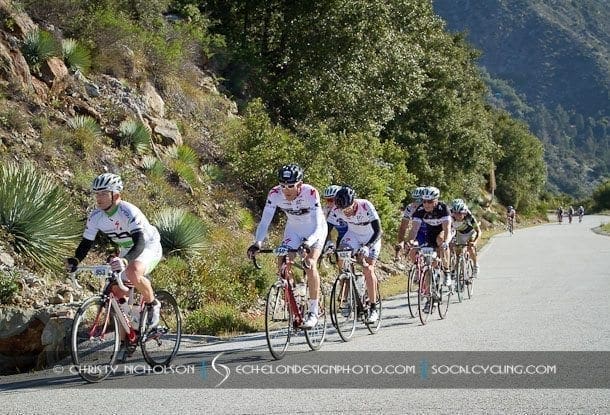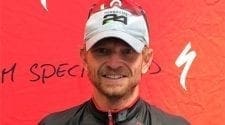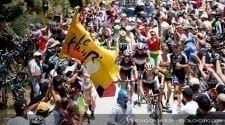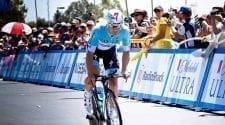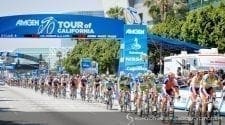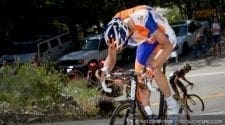SoCalCycling.com caught up with L’Etape du California winner Nate Whitman (Herbalife24) on his recent win in the epic ride that travels the same course as Stage 7 of the Amgen Tour of California from Ontario to Mt. Baldy.
L’Etape Du California Photo Gallery >
SoCalCycling.com: What is your riding / racing background and what club or team do you ride for?
Nate Whitman: I started cycling about 12 years ago as a complete beginner on the mountain bike. I read a magazine article about the Leadville 100, and decided to enter. I’d never been in a cycling event of any kind before. I didn’t even own a bike. I was completely clueless. But I was attracted to the challenge of the terrain and the altitude. My entry was accepted, I found a bike, started riding, and slowly gutted out that first year across the line. It was that experience that got me hooked. I really wanted to learn how to train and push myself to improve. I kept at it, and moved up in the categories. Over the next 5 years, I won the Cat 2, and then the Cat 1 California State Championship. I spent 2 years in what used to be Semi-Pro, and in 2008, I earned my upgrade to Pro. I gravitate toward the longer epic events like Leadville, the Vision Quest in Orange County, and the La Ruta stage race down in Costa Rica. I haven’t done as much on the road, but I am starting to focus on it more. Events like L’Etape have a lot of the same demands I’m used to off-road. And I’d love to some day have the opportunity to race a major stage race on the road.
As a mountain bike athlete, the team situation is a little different. I’m more of a “privateer” with personal sponsors. On nutrition, I work with Herbalife and their Herbalife24 line of Performance Nutrition products. Herbalife’s a major global company headquartered right here in L.A. The scientific team behind Herbalife24 are homegrown L.A. cyclists who really walk the walk. It’s a really unique opportunity. On the gear side, I ride Specialized bikes and equipment from Cynergy Cycles in Santa Monica, CA. Cynergy is a true flagship store with S-Works bikes, in-house BG Fit expert and the top factory mechanics in the area. In both of these cases, contributing off the bike is probably more critical than the racing itself. I’ve provided input in Herbalife24’s product development process. I also lead a “Base Camp” program at Leadville to introduce riders to the products and help Herbalife employees and customers train for the race. With Cynergy and Specialized, I am involved in the community, bringing new riders into the sport and working with riders and teams at all levels, from youth development to Specialized’s International stars.
My main teammate and training partner is fellow L.A.-based mountain bike pro Gerry Cody. Together, we’ve raced some of the toughest events and continuously push each other to improve. We’ve both been able to manage Top-10 finishes at Leadville. As “part-time pros” we both balance the demands of careers outside of cycling, and we’re thrilled to be able to hold our own with some of the Olympic and international stars that are now showing up. Last fall, we went to Costa Rica for La Ruta de los Conquistadores and finished with Gerry in 10th and me in 15th on GC, in a field of mostly Central and South American pros. In fact, we were the 3rd and 4th U.S. riders behind top factory pros Todd Wells (Specialized) and Alex Grant (Cannondale).
Goals for the future include some of the other major international mountain bike stage races, like the Cape Epic in South Africa. Earning Cat 1 upgrade on the road and competing against the top competition in iconic events like the Iron Horse in Durango, and Everest Challenge. And perhaps, some day getting a chance in a bigger road stage race.
SoCalCycling.com: How did the ride unfold and did you have a strategy in mind going into it?
Nate Whitman: Since the main objectives at L’Etape are the timed KOM segments, my strategy was to arrive at the base of KOM #1 at Glendora Mountain Road surrounded by other strong riders, and with as much gas left in the tank as possible. GMR is the kind of climb where a small group can work together and make better time than a solo rider. The grades aren’t that steep. The idea of a breakaway earlier in the day doesn’t make much sense. So prior to GMR, most riders just have fun and go a steady pace. I was really impressed with how the group obeyed the traffic signals and were really respectful getting out of Ontario and into the mountains. In terms of the KOM designation, it is based on the two climbs added together. GMR is important, but much bigger time gaps are possible on Baldy. So I wanted to do well on GMR, but also save something for the end of the day.
SoCalCycling.com: There was a large contingent of riders from the Breakaway from Cancer Masters Team and Team Blackstar Racing, can you tell us what tactics went on during the different portions of the course?
Both the Breakaway Masters and Blackstar from Orange County had about 7-8 strong riders each, and there were several soloists like me. Early in the day, before the KOMs, they used their numbers to take turns setting a good pace and discourage any attempted escapes from the field. They also kept the solo riders guessing as to who might be the strongest climbers in their groups. Everything stayed together until GMR, and at that point you have already covered more than 50 miles and over 5,000 feet of climbing, and the event is really just getting started!
We arrived at GMR in a group of about 25-30 riders. Just before the official starting point of the timed climb, there is a small rise off the turn off Sierra Madre. The pace picked up and split the group in half before we even hit the timing strip. So once we were on the real climb, there were about 10 riders together in front. In the first few km, David Schulhofer from Santa Fe, NM was the pace setter. I took some turns as did Trent Ford from Blackstar. The conditions were perfect. Not too windy, and the switchbacks seemed to inject some energy into our legs.
In L’Etape, the GMR segment is more than twice as long and high as the TT they do in the San Dimas Stage race. Its more than 8 miles and 2,000 feet vs. 4 miles and 1,000 feet. Early in the climb Breakaway and Blackstar each had 2 or 3 riders helping each other in the group. But, by the mid-way point where the SDSR TT stops, it was down to 4 riders. Schulhofer, Ford, myself, and legend Thurlow Rogers. Each of us without any teammate. From there to the top, it levels off slightly, which seemed to favor me a bit. I picked it up on some of the straightaways. Trent dropped back, then Thurlow. And finally with 1K to go to the KOM, I was able to pull away from David and get over the timing strip first.
After KOM #1, you traverse the Glendora Ridge Road toward Baldy Village. This section is un-timed, but riders still go strong to keep their momentum and aim for a good overall finishing time. Here is where the two teams regrouped a bit and worked together to save energy for the climb up Mt. Baldy and KOM #2. I was alone through this section, however. At first I was solo off the front coming off of the GMR climb. Then I actually flatted my rear tire, and had to change it and play catch up, after several riders passed me at the side of the road. Fortunately, the change was pretty smooth and I was able to work back up toward the front. I hit the timing strip at the bottom of Baldy with a few riders still ahead of me, but with them as a carrot up the road, I had enough to set a nice pace on Baldy and get the fastest KOM time.
Ultimately, L’Etape is not designed as a purely competitive event. It’s meant for riders of all abilities. The true test is yourself against the mountain and the elements. But its great to have other strong riders to push you to your personal best, and I was thrilled to get the King of the Mountains award. And we all had a good time sharing stories once we got to the top at the Baldy Ski Station.
SoCalCycling.com: Did you or the riders going for the win stop for feeds and fluids or did you have someone feeding you so you could keep riding the whole time?
Nate Whitman: It was a real mix out there. I think personal feeds are discouraged or even disallowed. The organizers don’t want extra cars out there getting in the way and creating unsafe situations. Most riders seemed to find a way to make a quick pit stop somewhere during the day. A few riders stopped at East Fork outbound and caught back on the descent. The entire Blackstar team stopped at the aid on Sierra Madre. Most of Breakaway and the rest of the pack kept going, but Blackstar worked together and caught back up quickly. I actually started the day in Ontario with a 3rd bottle in my jersey, and then stopped quickly at East Fork aid inbound after KOM #1 for a refill, and that was enough. I think Sierra Madre, prior to GMR, would be a safe place for them to allow family or friends to do personal bottle handups and cheer their rider on. There is lots of street parking, a wide shoulder, and its easy to access. Maybe for future years, they will consider making that officially “legal” within the event rules.
SoCalCycling.com: How did you prepare for the ride in your training and nutrition?
Nate Whitman: My early season race goal is typically the Vision Quest, which is an epic mountain bike race in the Santa Ana range in Orange County. It’s an amazing event for a good cause, put on by the Warriors Society, to raise funds for trail maintenance and advocacy. The course profile is actually similar to L’Etape, at least on paper. 55 miles, 11,000 feet of climbing, and 5-hour finishing times for the top riders. Of course with the VQ being off road with lots of singletrack, it’s a bit harder. That race was just a few weeks earlier, so for L’Etape it was really just maintaining that form and trying to stay fresh. In general, I train with a mix of longer endurance and climbing rides on both road and MTB, mixed with shorter more specific intense efforts. I jump in a lot of the group road rides in the Santa Monica area, with the LaGrange club and other teams. They are short and intense, so a good complement to longer efforts.
In terms of nutrition, Herbalife24 Prolong is my key source of fuel and hydration on the bike. It has a higher calorie content than many other drinks, so there typically is no need to augment with other foods. I have found over the years, that all liquid-based nutrition works best for me in intense events. I rarely eat any solid food in races. Prolong also has a strong protein component, along with B-vitamins and a broad electrolyte profile. Protein is key to reduce muscle breakdown in long events like L’Etape. A hidden benefit is that I believe it speeds recovery between training sessions of any length. Using Prolong over the course of a month of hard training, I stay slightly fresher throughout, so that each workout is a little better, and there is a noticeable cumulative effect over time. Recovery is a huge factor, more important than most of us probably realize. Herbalife24 Rebuild Endurance is an amazing recovery shake mix for use immediately after hard efforts. Rebuild Strength is a slightly different mix with more protein. I use it to increase my protein intake each day, and to make healthy shakes as a quick snack or meal.
Nutrition is really personal. You learn by trial and error over time. But I do think many newer riders struggle to find their sweet spot and find ways to over-complicate things. A lot of the marketing in the industry takes a “more is more” approach. They make nutrition seem really complex, and in turn, hope you’ll buy lots of different products. Like in many areas of life, the simplest approach is often the best. Herbalife has created a line that is simple to understand, with products that meet each nutritional objective at specific points in the training and recovery cycle. I really believe in these products. I’ve tested them from the altitude and dry air of Leadville, to the heat and humidity of the jungles in Costa Rica. They work.
SoCalCycling.com: How was the heat and did you have any sections of the course that felt harder than others?
Nate Whitman: The heat wasn’t quite as bad as I had feared. I think the Glendora Ridge road at the end of the day felt hottest. It is lower elevation than Baldy, and fully exposed. Baldy has a lot of shade cover. I was actually a little chilled at the top of Baldy, with the breeze and a soaked jersey. But the heat probably varied depending on your pace. Riders who hit the Ridge Road a bit later in the day probably were really suffering. Racing is like that. Fast times are impressive, but I am really more blown away by the people that are pushing themselves to the max, and out there finishing, no matter how long it takes. Sometimes they get the worst of the heat and other elements, just being exposed out there for so many hours. I was really moved seeing all the riders coming up Baldy later in the day. Some of them walking just to make sure they finished the event.
SoCalCycling.com: How did you like the Ontario start and climb up Euclid versus the start in Claremont that put you right on Mt. Baldy Road?
Nate Whitman: I think the Claremont start venue and initial sequence of turns were a little easier to manage, and got you out to street traffic faster. It was also easier to get back to after the event ends. So in that sense it was probably preferable. The first bit of work getting away from Ontario was pretty crowded. But the climb up Euclid is a nice ride and the approach to Mt. Baldy Rd. from that side has some twists and steep sections that made it interesting.
SoCalCycling.com: Do you have any tips for beginner or intermediate riders that would like to try something as challenging as the L’Etape du California?
Nate Whitman: Go for it! The beauty of cycling is that if you maintain your own pace, you can really go big. You can see a great variety of terrain and take things in from a unique perspective on the bike. I think most riders with at least a year or two on the bike, are probably capable of way more than they think they are. With a 2-3 months to prepare, most riders can probably go 2X or even 3X as long as their current comfort zone. If you feel good on a 30-40 mile ride with some decent climbing, then you can probably do 70-80 and get yourself up to Mt. Baldy.
Keep the training really simple. There is definitely a place for power meters and training logs, and expert coaches. But for the vast majority of us, 80% of the battle is in simply have basic life and time management skills, and finding ways to spend quality time on the bike. In one of of the greatest things about cycling as a beginner. If you use common sense and stick with it over time, you almost can’t help but see dramatic improvement.
On a weekly and monthly basis mix up your routine. Some longer rides at more moderate paces. Some shorter ones with greater intensity. Brief bursts, more sustained efforts. Don’t be afraid of being a little competitive and getting into group rides. Not every time out, but here and there, a little competition can push you in ways that you can’t do in isolation. And… Recovery! No amount of training can let you maximize your potential if you aren’t recovering between efforts, proper sleep, hydration, eating healthy foods, and utilizing the latest thinking on scientific nutrition and recovery products.
I think L’Etape du California is an amazing event and I hope they keep this great ride up to Baldy every year.
SoCalCycling.com: Thanks for the interview Nate and congratulations on what is truely and epic win!
No products found.



